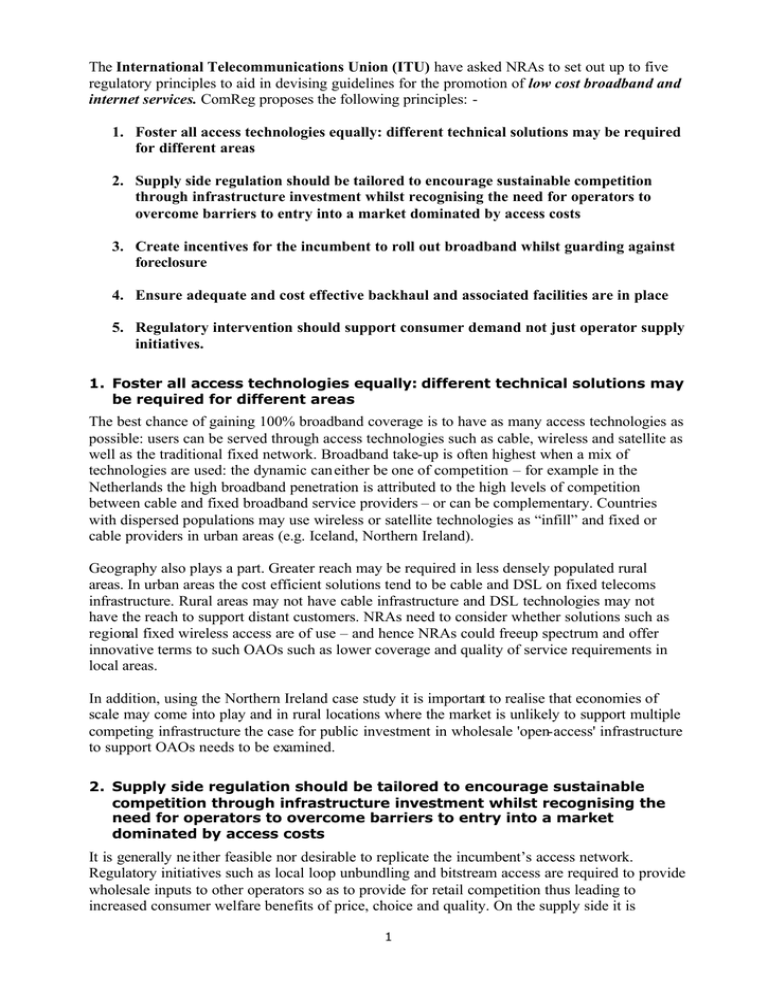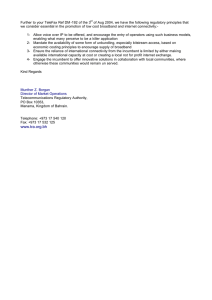International Telecommunications Union (ITU) low cost broadband and
advertisement

The International Telecommunications Union (ITU) have asked NRAs to set out up to five regulatory principles to aid in devising guidelines for the promotion of low cost broadband and internet services. ComReg proposes the following principles: 1. Foster all access technologies equally: different technical solutions may be required for different areas 2. Supply side regulation should be tailored to encourage sustainable competition through infrastructure investment whilst recognising the need for operators to overcome barriers to entry into a market dominated by access costs 3. Create incentives for the incumbent to roll out broadband whilst guarding against foreclosure 4. Ensure adequate and cost effective backhaul and associated facilities are in place 5. Regulatory intervention should support consumer demand not just operator supply initiatives. 1. Foster all access technologies equally: different technical solutions may be required for different areas The best chance of gaining 100% broadband coverage is to have as many access technologies as possible: users can be served through access technologies such as cable, wireless and satellite as well as the traditional fixed network. Broadband take-up is often highest when a mix of technologies are used: the dynamic can either be one of competition – for example in the Netherlands the high broadband penetration is attributed to the high levels of competition between cable and fixed broadband service providers – or can be complementary. Countries with dispersed populations may use wireless or satellite technologies as “infill” and fixed or cable providers in urban areas (e.g. Iceland, Northern Ireland). Geography also plays a part. Greater reach may be required in less densely populated rural areas. In urban areas the cost efficient solutions tend to be cable and DSL on fixed telecoms infrastructure. Rural areas may not have cable infrastructure and DSL technologies may not have the reach to support distant customers. NRAs need to consider whether solutions such as regional fixed wireless access are of use – and hence NRAs could freeup spectrum and offer innovative terms to such OAOs such as lower coverage and quality of service requirements in local areas. In addition, using the Northern Ireland case study it is important to realise that economies of scale may come into play and in rural locations where the market is unlikely to support multiple competing infrastructure the case for public investment in wholesale 'open-access' infrastructure to support OAOs needs to be examined. 2. Supply side regulation should be tailored to encourage sustainable competition through infrastructure investment whilst recognising the need for operators to overcome barriers to entry into a market dominated by access costs It is generally ne ither feasible nor desirable to replicate the incumbent’s access network. Regulatory initiatives such as local loop unbundling and bitstream access are required to provide wholesale inputs to other operators so as to provide for retail competition thus leading to increased consumer welfare benefits of price, choice and quality. On the supply side it is 1 Version 1.0 important to ensure that competition is sustainable. The regulatory focus should be to develop a competitive environment with a view to relaxing regulatory intervention as the market develops. In the fixed telecoms market a competing operator can look to take local loop unbundling from an incumbent or to avail of a wholesale broadband product in order to produce a retail product. The wholesale broadband product would typically attract a lower upfront investment cost, such investment potentially being a fairly significant entry barrier, versus an LLU implementation. However in order to encourage infrastructure based competition a Regulator may look to allow lower margins for a product which is largely resale, as opposed to a product relying on infrastructure investment. This can be achieved by setting retail minus pricing for products which are predominantly resale versus cost based wholesale pricing for investme nt projects. Again no choice as to the best access mechanism should be made: LLU and Bitstream should both be required as they provide entry options. Although LLU provides more control for the OAO, bitstream facilitates lower cost entry. Using the ‘ladder of investment’1 theory operators may gain critical mass using bitstream and move to full product differentiation and infrastructure competition through LLU. 3. Create incentives for the incumbent to roll out broadband whilst guarding against foreclosure Moving from a telephony based revenue per minute business model to a broadband centred focus is a shift of mind set for most incumbents. It can also be investment heavy. Incumbents often argue that they should be allowed an ‘access holiday’ to recoup the investment required to deploy broadband. Regulators need to ensure that adequate wholesale access is provided so as to avoid foreclosure but also must set their pricing principles so that incumbents can make a (regulated) return on investment sufficient to maintain the network and have the incentive to invest and aggressively roll out broadband. Therefore retail pricing or bundling promotions which encourage consumer take up should be examined on a case by case basis rather than being subject to a blanket prohibition. A solution which may grow the market is a cost effective manner could be for example the matching of retail promotions with wholesale promotions so that the incumbent grows overall volumes but new entrants can compete at the retail level. NRAs may also wish to undertake measures to increase competition in the mobile market on the basis that declines in voice revenues (through mobile substitution) will create the impetus for the incumbent to drive revenues from Internet and broadband services 4. Ensure adequate and cost effective backhaul and associated facilities are in place Headline prices often quoted are the monthly rental charges for a local loop or for a bitstream product. However these often represent only a small fraction of the real costs of accessing wholesale products. Far more onerous may be collocation charges (in the case of LLU); charges for IT systems or OSS; or charges for backhaul (often at retail rates which obviously the incumbent does not have to use for its retail product). Therefore NRAs should ensure that business cases take into account all these charges and should not allow incumbents to gain from unregulated/ lightly regulated inputs. NRAs should benchmark incumbent charges against those of carriers’ carrier type operations. NRAs should ensure that incumbents develop wholesale products that are sufficiently unbundled so as to allow new entrants to only buy those elements for which they have need. As stated previously, in locations where the market is unlikely to support multiple competing infrastructure (esp. rural areas) it may be worthwhile to investigate case for public investment in wholesale 'open-access' infrastructure that can support multiple service providers. 1 See ERG Common Position on Remedies April 2004 available on www.erg.eu.int. 2 Version 1.0 5. Regulatory intervention should support consumer demand not just operator supply initiatives. Regulators need to be aware that broadband success requires both consumer demand and operator supply. Whilst regulation is often focussed on the supply side, it can also facilitate consumer demand. Although the NRA has little influence over the consumer awareness aspect of demand it can ensure that consumer choice is facilitated and processes are developed which simplify the take up of broadband by consumers. NRAs should consider the circumstances in which consumers will be migrating to broadband and ensure likely consumer requirements can be accommodated. For example migration from ISDN to DSL solutions should be available as a seamless process for the consumer as it is likely that customers who have experienced ISDN will be early adopters of broadband. On the process issues, Regulators need to ensure that all processes allowing ongoing competition are in place. For example, to avoid customers being effectively locked in to a single supplier the Regulator should ensure that seamless migration between suppliers is available, at appropriate pricing. If this is not in place there are significant barriers to changing supplier as business critical services may suffer an interruption. Another key issue is to ensure that delivery times for these products is reasonable. John Doherty Chairperson Commission for Communications Regulation 3
